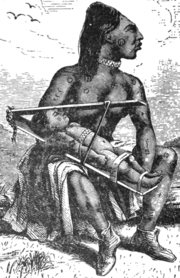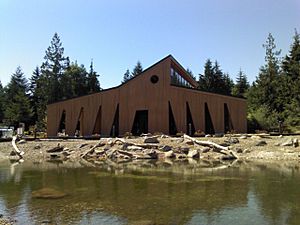Squaxin Island Tribe facts for kids
Quick facts for kids
Squaxin Island Indian Reservation
|
|
|---|---|
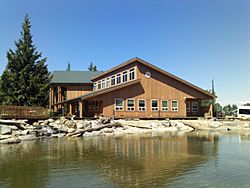
South view of the Squaxin Museum, Library, and Research Center in Kamilche.
|
|
| Nickname(s):
People of the Water
|
|
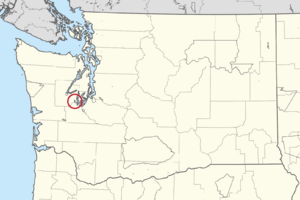
Location of Squaxin Island Indian Reservation in Washington State
|
|
| Country | United States |
| State | Washington |
| County | Mason |
| Negotiated | December 26, 1854 |
| Government | |
| • Type | Tribal Council |
| Elevation | 207 ft (63 m) |
| Population
(2020)
|
|
| • Total | 509 |
| Time zone | UTC−8 (Pacific (PST)) |
| • Summer (DST) | UTC−7 (PDT) |
| ZIP Code |
98584
|
| Area code(s) | 360 |
| Website | www.squaxinisland.org |
The Squaxin Island Tribe is a federally recognized tribe located in Mason County, Washington. This means the United States government officially recognizes them as a Native American nation. The tribe's people are descendants of several Southern Coast Salish groups. These include the Squaxin, Sahewamish, T'Peeksin, Squiaitl, Stechass, and Nusechatl.
Long ago, the ancestors of the Squaxin Island Tribe lived around several inlets of the South Puget Sound. The Squaxin Island Reservation was created in 1854 by the Treaty of Medicine Creek. It included all of Squaxin Island. Today, the reservation also has small pieces of land nearby. While tribal members no longer live on Squaxin Island itself, 509 people live on other reservation and trust lands. In 2010, the total number of tribal members was 1,022.
Contents
History of the Squaxin People
The Coast Salish groups that formed the Squaxin Island Tribe historically lived along the seven inlets of the South Puget Sound. These areas had names like S'hotl-Ma-Mish (Carr Inlet) and Steh-Chass (Budd Inlet, near modern-day Olympia). The Squaxin people spoke a language called Lushootseed, which is part of the Salishan language family. Around 1780, these groups, along with the Twana and Suquamish, had about 1,000 people.
Unlike other tribes in the area, the Squaxin people did not rely on large rivers for salmon. Instead, they focused on the saltwater sound and smaller streams near the inlets. Families lived together in longhouses within villages. They were connected by family ties, forming a wide system of alliances. An ancient site called Qwu?gwes was used for about 700 years to process food. It shows that people harvested a lot of salmon and shellfish there. The Squaxin traded with other groups, using routes that went overland to the Columbia Basin and by sea throughout the Puget Sound.
Treaties and Land Changes
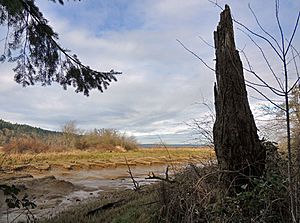
In the 1840s and 1850s, more white settlers began to arrive in the South Puget Sound area. In 1853, the Washington Territory was created, which included Squaxin lands. In 1854, the new governor, Isaac Stevens, started to make treaties with the tribes. These treaties would give their land to the United States. The Squaxin tribes were among the first to sign the Medicine Creek Treaty on December 26.
This treaty meant the Squaxin gave up all their mainland claims. In return, they received Squaxin Island, cash payments for twenty years, and recognition of their traditional fishing and hunting rights. However, the reservations were much less valuable than the land they had given up. When the Nisqually tribe realized how unfair the deal was, their leader Chief Leschi started the Puget Sound War. He hoped to change the treaty. Even though the Squaxin Tribe did not fight, they were forced to stay on their reservation during the war. The small, forested island did not provide enough food for the 375 Squaxin tribe members. After the war, most families left the island and returned to live around the South Puget Sound, but they no longer owned the land.
Protecting Fishing Rights
At first, the government honored its treaties with the tribes. But as more white settlers moved in, they started to interfere with the tribes' fishing rights. By 1883, there were over forty salmon canneries run by white settlers. They also used new fishing methods that stopped many salmon from reaching tribal fishing areas. When Washington Territory became a state in 1889, new laws were passed. These laws aimed to limit tribal fishing, supposedly for "conservation." However, some historians say they were designed to protect white fisheries. By 1897, the state banned the use of weirs, which Indigenous fishermen traditionally used.
In the 1960s and 1970s, Native Americans in Washington State were inspired by the Civil Rights Movement. They demanded that Washington State honor its treaty promises. Native activists like Billy Frank, Jr. used peaceful protests and demonstrations to assert their right to fish. In 1970, the U.S. Attorney General finally sued the state. The Squaxin Island Tribe was one of the tribes asked to provide expert witnesses. In a famous court decision known as the Boldt decision, the U.S. District Court recognized the tribes' original right to fish. This decision was upheld by the Supreme Court. Since then, the Squaxin Island Tribe has become one of the co-managers of the state's fisheries. Many tribal members now earn their living from the yearly salmon catch.
The Squaxin Island Tribe was one of the first Native American tribes in the U.S. to work with the federal government on a "Self Governance Demonstration Project." This project gives tribes more control over their own programs and services.
Culture and Beliefs
The Squaxin people told stories through songs, which were performed with dances to the beat of a drum. Other important traditions included carving cedar canoes, weaving baskets and fishing nets, and face-painting. They used red and black colors made from ground-up rocks. Like other groups in the Pacific Northwest, upper-class Squaxin people practiced head-flattening. This was a cosmetic practice where infants' foreheads were gently shaped.
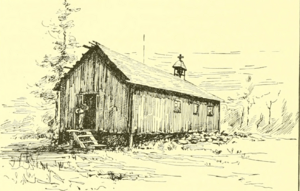
Traditional Squaxin religious beliefs were similar to those of other tribes in the Pacific Northwest. They involved shamanism, which is a practice where a spiritual leader connects with the spirit world. For many years after the Puget Sound War, many Squaxins continued these traditional beliefs.
A new religious movement began in 1882 when Squaxin man John Slocum founded the Indian Shaker Church. He started it after a near-death experience. This church blended parts of Catholic, Protestant, and Indigenous beliefs. It focused on personal communication with God rather than written texts. The movement quickly spread throughout the Pacific Northwest. Native American religious movements faced challenges after the Battle of Wounded Knee, and Indian Shakers were sometimes treated unfairly by the government. Still, by the end of the 20th century, there were over 2,000 followers. Today, most Squaxin people consider themselves Protestant.
The Squaxin Tribe Today
As of 2010, the Squaxin tribe had 1,022 registered members. This was an increase from 302 members in 1984. The 2020 census showed 509 people living on tribal lands (reservation and trust lands). This was up from 445 in 2000. Most of these residents identify as Native American only (281 people) or of mixed race (126 people).
Tribal Lands and Growth
In recent years, the Squaxin Island Indian Reservation has gained more land around its original areas. In the 1970s, they acquired land in Kamilche, where many tribal members now live. This land was placed under trust with the Department of the Interior. The tribe also worked to close the 31-acre Squaxin Island State Park in the 1990s and bought the property in 2015.
In December 2021, the Squaxin Island Tribe reached an agreement with Port Blakely Companies, a timber company. This agreement allowed the tribe to get back 1,000 acres of their ancestral land. Two miles of waterfront and 125 acres of tidelands on Little Skookum Inlet in Mason County were returned to the tribe for free. Getting this shoreline back gave the tribe direct access to Puget Sound again, including some of the best shellfish beds in the area. In a separate deal, the tribe bought 875 acres of upland forest. This land, known as the Kamilche property, was acquired by Port Blakely after the 1854 Medicine Creek Treaty was signed, 167 years earlier. Tribal chairman Kris Peters stated that the tribe plans to use the land for nature conservation and ceremonial purposes, not for development.
Overall, the Squaxin Tribe owns 26.13 acres (105,700 m2) in Kamilche. They also have two pieces of off-reservation trust land near Kamilche. Additionally, they own a plot of 6.03 acres (24,400 m2) across Pickering Passage from Squaxin Island and a plot of 35.93 acres (145,400 m2) on Harstine Island, across Peale Passage. The total land area, including off-reservation trust lands, is 6.942 km² (2.68 sq mi, or 1,715.46 acres).
Squaxin Island Museum
Construction on the Squaxin Island Museum, Library and Research Center (MLRC) began in 1999 and it opened in 2002. It was built to teach both Squaxin people and visitors about the tribe's culture. The building's shape is designed to look like a Thunderbird from the side. The land where the museum stands was given to the tribe by the Taylor family, who own Taylor Shellfish nearby. The MLRC offers guided tours, cultural classes, and many exhibits.
Paddle to Squaxin Island 2012
In 2012, the Squaxin Island Tribe was chosen to host the yearly Tribal Canoe Journey. These journeys are annual events organized by Indigenous peoples of the Pacific Northwest. They help to bring back traditional ways of harvesting timber, making large ocean-going canoes, and teaching canoe skills to new generations.
About 40,000 people attended or visited the "Paddle to Squaxin Island" journey. The Squaxin Museum and The Evergreen State College hosted it, with funding from a grant. The events and meals were held in an old baseball field. The usually quiet community was full of activity for a whole week. Months before the event, major construction took place. Many parking lots were created, a campground was built, and a Reflecting Pond was added to the Tribal Government Campus. A total of 102 canoes landed on Squaxin for the "Paddle to Squaxin Island" journey.
Economic Activities
Fishing and lumber are important industries for the tribe. The tribe also runs Salish Cliffs Golf, the Skookum Creek Tobacco Company, and the Little Creek Casino and Resort.
See also
 In Spanish: Tribu de la isla Squaxin para niños
In Spanish: Tribu de la isla Squaxin para niños


